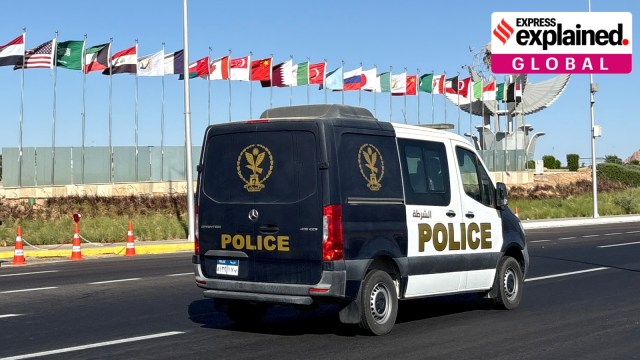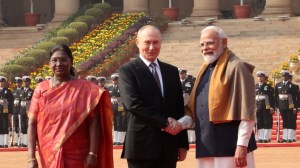Sharm el-Sheikh: Venue of many international meetings, now hosting Trump-led ‘Summit for Peace’
The ‘Summit for Peace’ in Sharm el-Sheikh will be attended by leaders from around the world
 A police vehicle passes past flags of participating countries at a summit hosted by the Egyptian government to celebrate the signing Israel-Hamas ceasefire deal at the Red Sea city of Sharm el-Sheikh, Egypt, Sunday, October 12, 2025. (AP Photo)
A police vehicle passes past flags of participating countries at a summit hosted by the Egyptian government to celebrate the signing Israel-Hamas ceasefire deal at the Red Sea city of Sharm el-Sheikh, Egypt, Sunday, October 12, 2025. (AP Photo)World leaders are gathering at Sharm el-Sheikh, Egypt to discuss plans for ending the two-year long conflict in Gaza, deemed by scholars and UN experts to be a “genocide” perpetrated by Israel, and usher in lasting peace in the region.
This will not be the first major international conference to be held in Sharm el-Sheikh, a town near the southern tip of the Sinai peninsula. In fact, the fishing village-turned-resort town has emerged in recent years as one of the region’s most happening tourist destinations with a thriving hospitality industry making it an ideal location for high-profile gatherings in the region.
Brief history of Sharm el-Sheikh
Sharm el-Sheikh lies on a promontory overlooking the Straits of Tiran, at the mouth of the Gulf of Aqaba. Once a sleepy fishing village, Sharm el-Sheikh today is a bustling resort town, in a large part spurred by its strategic location — Israel’s only direct access to the Red Sea lies through the Straits of Tiran — and consequent developments.
By the mid-20th century, Sharm el-Sheikh had emerged as a major port and naval base for the Egyptian Navy. It was conquered by Israel during the Suez Crisis of 1956, overseen by a UN peacekeeping force from 1957 to 1967, reconquered by Israel in 1967 during the Six Day War, and held by the Zionist state until 1982.
Since being handed back to the Egyptians, Sharm el-Sheikh has grown as a thriving tourist town. In 1982, Egypt’s then-president Hosni Mubarak had designated Sharm El Sheikh as “The City of Peace”, and invited national and global investment which transformed the city into a regional hospitality hub. By 2000, there were almost 100 resorts in the city, a hundred-fold increase from the sole resort that stood in 1982.
Hosted many major international conferences
It is the thriving hospitality industry in Sharm el-Sheikh that makes it an ideal location for hosting international conferences in the region, including previous Israel-Palestine peace talks. Here are a few important examples.
- 01
Israel-Palestine Peace talks, 1999
On September 4, 1999, Israel Prime Minister Ehud Barak and Palestine Liberation Organisation (PLO) Chairman Yasser Arafat signed the historic ‘Sharm el-Sheikh Memorandum’. The meeting was overseen by the US, represented by Secretary of State Madeleine Albright, and the memorandum was co-signed by Egypt President Hosni Mubarak and King Abdullah of Jordan.
The meeting was an attempt to break the deadlock between the PLO and Israel, more than half a decade after the signing of the landmark Oslo Accords. Among other things, the memorandum agreed to establish Palestinian self-governance in Gaza and the release of Palestinians from Israeli prisons.
- 02
Emergency Summit, 2000
An emergency summit was held in Sharm el-Sheikh on October 17, 2000, following the outbreak of the Second Intifada. Participants included Palestinian National Authority (PNA) President Yasser Arafat, Israel PM Ehud Barak, US President Bill Clinton, Egypt President Hosni Mubarak, King Abdullah of Jordan, UN Secretary-General Kofi Annan, and the European Union High Representative Javier Solana.
The closing statement made a call for the immediate end of violence and the resumption of permanent status negotiations, and established a fact-finding committee to determine the cause of the violence; its findings were eventually published in 2001 in the Mitchell Report.
- 03
Sharm el-Sheikh Summit, 2005
The Sharm el-Sheikh Summit of 2005 was a high-profile diplomatic meeting between Egypt, Israel, Jordan, and the PNA that took place on February 8, 2005. It was an organised effort to end the Second Intifada. Hosted by Egyptian President Hosni Mubarak and King Abdullah of Jordan, the talks were attended by PNA chief Mahmoud Abbas — Arafat had passed in 2004 — and Israel PM Ariel Sharon.
The summit concluded with a statement to return to the roadmap for peace outlined by Washington in 2002; Abbas and Sharon agreed to a ceasefire, although many Palestinian groups, including Hamas, were not bound by the PNA’s undertaking. Abbas would later negotiate a separate truce with Hamas.
- 04
World Economic Forum on the Middle East & North Africa, 2006, 2008 and 2014
The World Economic Forum (WEF) holds its principal, and best known, meeting at Davos each January. But it also holds regional meetings around the world. Sharm el-Sheikh has hosted three WEF on the Middle East and North Africa meetings: in 2006, 2008, and 2014.
The summits have discussed a number of issues, from how to promote peace and stability in the conflict-ridden region, to increasing investments in emerging technology, climate action, and critical infrastructure.
- 05
First EU-Arab League Summit 2019
The leaders of the EU and the League of Arab States (LAS) met on February 25-25 in Sharm el-Sheikh for the first ever summit between the two regional blocs. They said in a final statement they were determined to start a “new era” of cooperation in different areas.
Among other things, discussions were dominated by issues of migration, security, and the wars in Yemen, Syria, and Libya. While the rhetoric remained hopeful and lofty, analysts said that nothing fruitful came out of the “ceremonial” meeting, which some dubbed as a “publicity stunt” for Egypt PM Abdel Fattah El-Sisi.
- 06
COP27, 2022
The 27th Conference of the Parties to the United Nations Framework Convention on Climate Change (COP27) took place in Sharm el-Sheikh on November 6-20, 2022. The conference concluded with a historic decision to establish a loss and damage fund, a financial mechanism established at COP27 to help developing countries cope with the severe, unavoidable consequences of climate change
That said, progress on operationalising this fund has been disappointing. The conference also failed to secure a commitment to phase out fossil fuels.
- 01
- 02
- 03
- 04
- 05






































